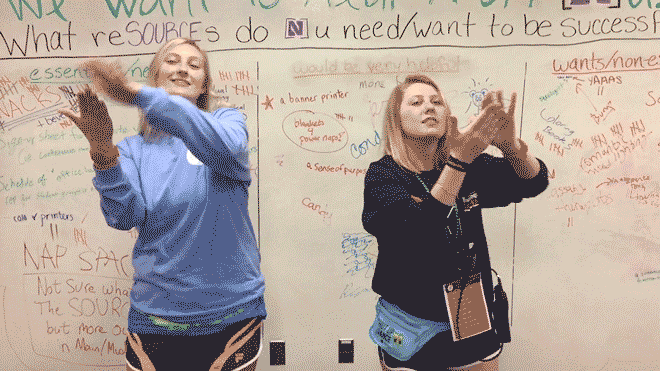In the midst of their last-minute fundraising push, we sat down with Alicia Kranjc and Kayla Brackett, DM finance co-chairs, to discuss their work.
How has fundraising been different this year from previous years?
AK: A thing that we really pushed this year was early fundraising. We had early registration this year, so that meant the dancers could register last May. And with that we had about 200 early registrant,s meaning they could create their Classy pages, have that Classy page all throughout the summer if they did want to fundraise with that Classy page - and a lot of people did. We also had an emphasis on fundraising initiative days this year, like with Giving Tuesday, which is a day in the fall. We don’t really have a lot of income coming into Dance Marathon, income through the fall, traditionally our trajectory of income is basically just exponential towards the actual date of Dance Marathon, but with that day in fall we had this awesome bump of fundraising which is really cool and very different and we set the goal for that day at $25,000 and ended up raising $65,000. So a lot of people started fundraising early, a lot of people got inspired, a lot of people reached their $400 minimum by that Tuesday which is reall, really cool. We kind of followed that up with a lot of little things throughout the quarter.
KB: In addition to that, we just emphasized active fundraising during the weekend of, because we’ve always had, like Alicia said, great momentum up until the weekend and of course we still accept donations up until Block Ten, but we never had a campaign or anything during the thirty hours to continue fundraising other than the donate button on our website. So this year we started a phonathon where we have members of finance and non-thirty hour committees calling past donors seeing if they would like to contribute to this year’s campaign as well as the $10,000 in 10 hours initiative, through which we’ve already raised $19,000. We’re very excited with the success of that.
What has been done to increase inclusivity for dancers who don’t have the same financial resources as others?
AK: We could focus on the registration fee first, this was the very first year that Dance Marathon was recognized as by ASG as an A-status organization. So, that means that we got funded as an A-status organization, so when we applied in the spring of last year we applied for a bunch of different line items which we used for production and we ended up getting funded partially as it was our first year as an A-status organization. That allowed us to lower our registration fee from $50 to $35. We also continued to offer the scholarship option for dancers who were on financial aid, they are qualified for this scholarship to get their registration fee waived. So just in terms of entry and signing up for Dance Marathon we worked really hard to kind of lower that barrier of entry this year. Next year, hopefully since we have proven to ASG that we are a financially stable organization that they can once again actually fund us with more money and then we can lower the registration fee again, making it even more accessible in terms of actually signing up for the event.
KB: Throughout the year we have worked closely with Dancer Beneficiary Relations, to meet with dancers on an individual basis to make sure they can reach that $400 goal. Dancers were set up with a fundraising mentor if they would like and that’s someone who is an upperclassman that has done Dance Marathon that has all the tricks of the trade to kind of walk them through the process - it's mostly for freshman or first time dancers. They would coordinate canning groups and different group fundraisers if you didn't have a team to do a bake sale or one of those traditional fundraising campaigns with. We definitely emphasized canning and we also had some matching programs from different student groups on campus from RHA, to PHA and IFC that were able to help individual dancers reach their goal.
Do you expect to exceed last year’s total?
KB: Honestly, it's up in the air. It is always down to the wire because we are, like we said, accepting donations until Block Nine or Block Ten, so it's yet to be determined what the total will be.
AK: We actually do have data from the previous years, and it does vary a little bit per year. There’s a couple waves of dancers I guess. I would say a lot of dancers raise around right at that $400 mark and then they kind of just stop right at that mark. But a lot of dancers get to that $600 to $650 range as well so I would say on average a dancer raises about $550. And you do have some of those fundraisers who really go above and beyond and go H.A.M. on their fundraising, and it’s something that they share with everyone around them.
Now, show us your go-to dance move.
